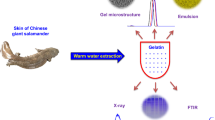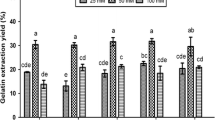Abstract
Gelatin extraction yield increased with the increase of acetic acid concentration and temperature. Gelatin extracted from shaari skin using 0.1 N acid solutions and temperatures of 323 and 353 K gave highest protein content comparable to that of commercial bovine and porcine gelatins. In general, gelatin extracted from shaari gelatin showed lower onset of glass transition temperature than mammalian gelatins. For shaari skin gelatin, the onset of glass transition temperature decreased with the increase of extraction temperature up to 323 K and then remained nearly constant. The decrease in glass transition was more pronounced for gelatin extracted at 0.01 N compared to the 0.1 and 1.0 N samples. Unfolding temperature decreased exponentially with the increase of extraction temperature. The unfolding temperature shifted to lower temperature, and the decrease was more pronounced in the case of higher (1.0 N) concentrated samples. The extraction concentration and temperature did not show significant effect on the onset solids-melting temperature.


Similar content being viewed by others
Abbreviations
- T gi :
-
Onset temperature of glass transition (K)
- T gp :
-
Peak temperature of glass transition (K)
- T ge :
-
End temperature of glass transition (K)
- T mi :
-
Onset temperature of solids-melting (K)
- T mm :
-
Maximum slope temperature of solids-melting (K)
- T mp :
-
Peak temperature of solids-melting (K)
- T me :
-
End temperature of solids-melting (K)
- T ui :
-
Onset unfolding temperature (K)
- T um :
-
Maximum slope of unfolding temperature (K)
- T up :
-
Peak of unfolding temperature (K)
- X w :
-
Moisture content (g/100 g sample)
- ΔC p :
-
Change of specific heat (J/kg K)
- ΔH u :
-
Enthalpy change for unfolding (kJ/kg)
- ΔH m :
-
Enthalpy change for solids-melting (kJ/kg)
References
Karim AA, Bhat R. Gelatin alternatives for the food industry: recent developments, challenges and prospects. Trends Food Sci Technol. 2008;19(12):644–56.
Montero P, Gómez-Guillén MC. Extracting conditions for megrim (Lepidorhombus boscii) skin collagen affect functional properties of the resulting gelatin. J Food Sci. 2000;65:434–8.
Wainewright FW. Physical tests for gelatin and gelatin products. In: Ward AG, Courts A, editors. The science and technology of gelatin. New York: Academic Press; 1977. p. 507–34.
Hinterwaldner R. Raw material. In: Ward AG, Courts A, editors. The science and technology of gelatin. New York: Academic Press; 1977. p. 295–314.
Gennadios A, McHugh TH, Weller CL, Krochta JM. Edible coatings and films based on proteins. In: Krochta JM, Baldwin EA, Nisperos-Carriedo M, editors. Edible coatings and films to improve food quality. Lancaster: Technomic Publishing Company; 1994. p. 201–78.
Slade L, Levine H. Polymer-chemical properties of gelatin in foods. In: Pearson AM, Dutson TR, Bailey AJ, editors. Collagen as food: vol 4. Advances in meat research, vol. 4. New York: Van Nostrand Reinhold; 1987. p. 251–66.
Haug IJ, Draget KI, Smidsrod O. Physical and rheological properties of fish gelatin compared to mammalian gelatin. Food Hydrocoll. 2004;18:203–13.
Leuenberger BH. Investigation of viscosity and gelation properties of different mammalian and fish gelatins. Food Hydrocoll. 1991;54:353–61.
Zhang S, Wang Y, Herring JL, Oh JH. Characterization of edible film fabricated with channel catfish (Ictalurus punctatus) gelatin extract using selected pretreatment methods. J Food Sci. 2007;72(9):C498–503.
Yang H, Wang Y, Zhou P, Regenstein JM. Effects of alkaline and acid pretreatment on the physical properties and nanostructures of the gelatin from channel catfish skins. Food Hydrocoll. 2008;22:1541–50.
Zhou P, Regenstein JM. Optimization of extraction conditions for Pollock skin gelatin. J Food Sci. 2004;69(5):C393–8.
Rahman MS. State diagram of date flesh using differential scanning calorimetry (DSC). Int J Food Prop. 2004;7(3):407–28.
Rahman MS. State diagram of foods: its potential use in food processing and product stability. Trends Food Sci Technol. 2006;17:129–41.
Rahman MS. Food stability beyond water activity and glass transition: macro-micro region concept in the state diagram. Int J Food Prop. 2009;12(4):726–40.
D’Cruzand NM, Bell LN. Thermal unfolding of gelatin in solids as affected by the glass transition. J Food Sci. 2005;70(2):E64–8.
Bell L, Touma DE. Glass transition temperatures determined using a temperature-cycling differential scanning calorimetry. J Food Sci. 1996;61(4):807–28.
Marshall AS, Petrie SEB. Thermal transitions in gelatin and aqueous gelatin solutions. J Photogr Sci. 1980;28:128–34.
Sablani SS, Kasapis S, Al-Rahbi Y, Al-Mugheiry M. Water sorption isotherms and glass transition properties of gelatin. Dry Technol. 2002;20(10):2081–92.
Sobral PJA, Habitante AMQB. Phase transitions of pigskin gelatin. Food Hydrocoll. 2001;15:377–82.
Vanin FM, Sobral PJA, Menegalli FC, Carvalho RA, Habitante AMQB. Effects of plasticizers and their concentrations on thermal and functional properties of gelatin-based films. Food Hydrocoll. 2005;19:899–907.
Rahman MS, Al-Saidi GS, Guizani N. Thermal characterization of gelatin extracted from yellowfin tuna skin and commercial mammalian gelatin. Food Chem. 2008;108:472–81.
Gomez-Guillen M, Montero P. Method for the production of gelatin of marine origin and product thus obtained. International Patent PCT/S01/00275. 2001.
AOAC. Official methods of analysis. 15th ed. Washington, DC: Association of Official Analytical Chemists; 1990.
Pico-Tag. Amino acid analysis system. Midford: Waters Corporation; 1984.
Rahman MS, Al-Mahrouqi AI. Instrumental texture profile analysis of gelatin gel extracted from grouper skin and commercial (bovine and porcine) gelatin gels. Int J Food Sci Nutr. 2009;60(S7):229–42.
Gudmundsson M, Hafsteinsson H. Gelatin from cod skins as affected by chemical treatments. J Food Sci. 1997;62:37–47.
Jamilah B, Harvinder KG. Properties of gelatins from skins of fish-black tilapia (Oreochromis mossambicus) and red tilapia (Oreochromis nilotica). Food Chem. 2002;77:81–4.
Gomez-Guillen MC, Turnay J, Fernandez-Diaz MD, Ulmo N, Lizarbe MA, Montero P. Structural and physical properties of gelatin extracted from different marine species: a comparative study. Food Hydrocoll. 2002;16:25–34.
Mizuta S, Yoshinaka R, Sato M, Sakaguchi M. Hot-water solubility of collagen from the muscle of kuruma prawn. Fisheries Sci. 1995;61:536–7.
Peterson BR, Yates JR. Gelatin extraction. United-States-Patent. 4 064 008. Novo Industri AS. 1977.
Eysturskaro J, Haug IJ, Elharfaoui N, Djabourov M, Draget KI. Structural and mechanical properties of fish gelatin as a function of extraction conditions. Food Hydrocoll. 2009;23:1702–11.
Djabourov M, Lechaire J, Gaill F. Structure and rheology of gelatin and collagen gels. Biorheology. 1993;30:191–205.
De Batista TM, Martins VCA, De Guzzi Plepis AM. Thermal behavior of in vitro mineralized anionic collagen matrices. J Therm Anal Calorim. 2009;95(3):945–9.
Joly-Duhamel C, Hellio D, Djabourov M. All gelatin networks: 1. Biodiversity and physical chemistry. Langmuir. 2002;18:7208–17.
Arnesen JA, Gildberg A. Extraction and characterisation of gelatine from Atlantic salmon (Salmo salar) skin. Bioresour Technol. 2007;98:53–7.
Zhou P, Regenstein JM. Effects of Alkaline and acid pretreatments on Alask Pollock skin gelatin extraction. J Food Sci. 2005;70(6):C392–6.
Balian G, Bowes JH. The structure and properties of collagen. In: Ward AG, Courts A, editors. The science and technology of gelatin. New York: Academic Press; 1977. p. 1–31.
Rother J. Edible gelatin types, properties, use and application in the food industry. Food Tech Europe. 1995;1(5):32–42.
Sarabia AI, Gomez-Guillen MC, Montero P. The effect of added salts on the viscoelastic properties of fish skin gelatin. Food Chem. 2000;70:71–6.
Arnesen JA, Gildberg A. Preparation and characterisation of gelatine from the skin of harp seal (Phoca groenlandica). Bioresour Technol. 2002;82:191–4.
Badii F, Howell NK. Fish gelatin: structure, gelling properties and interaction with egg albumen proteins. Food Hydrocoll. 2006;20:630–40.
Johnston-Banks FA. Gelatin. In: Harris P, editor. Food gels. London: Elsevier Applied Science Publ; 1990. p. 233–89.
Ledward DA. Gelation of gelatin. In: Mitchell JR, Ledward DA, editors. Functional properties of food macromolecules. London: Elsevier Applied Science Publ; 1986. p. 171–201.
Burjandze TV. Hydroxy-proline content and location in relation to collagen thermal stability. Biopolymers. 1979;18:931–6.
Mizuno K, Hayashi T, Bachinger HP. Hydroxylation-induced stabilization of the collagen triple helix. Further characterization of peptides with 4(R)-hydroxyproline in the Xaa position. J Biol Chem. 2003;278:32373–9.
Badea E, Miu L, Budrugeac P, Giurginca M, Masic A, Badea N, Gatta GD. Study of deterioration of historical parchments by various thermal analysis techniques complemented by SEM, FTIR, UV–VIS–NIR and unilateral NMR Investigations. J Therm Anal Calorim. 2008;91:17–27.
Norland RE. Fish gelatin technical aspects and applications. In: Bland SJ, editor. Photographic gelatin. London: Royal Photographic Society; 1987. p. 266–81.
Gilsenan PM, Ross-Murphy SB. Rheological characterization of gelatins from mammalian and marine sources. Food Hydrocoll. 2000;14:191–5.
Anker M, Stading M, Hermansson A. Effects of pH and gel state on the mechanical properties, moisture contents, and glass transition temperatures of whey protein films. J Agric Food Chem. 1999;47:1878–86.
Gimenez B, Turnay J, Lizarbe MA, Montero P, Gómez-Guillén MC. Use of lactic acid for extraction of fish skin gelatin. Food Hydrocoll. 2005;19:941–50.
Asghar A, Henrickson RL. Chemical, biochemical, functional, and nutritional characteristics of collagen in food system. Adv Food Res. 1982;28:231–372.
Acknowledgements
The authors would like to acknowledge the support of Sultan Qaboos University toward this research in developing fish skin gelatin. Mr. Ghalib Al-Saidi has been awarded a Ph. D. scholarship from Sultan Qaboos University.
Author information
Authors and Affiliations
Corresponding author
Rights and permissions
About this article
Cite this article
Al-Saidi, G., Rahman, M.S., Al-Alawi, A. et al. Thermal characteristics of gelatin extracted from shaari fish skin. J Therm Anal Calorim 104, 593–603 (2011). https://doi.org/10.1007/s10973-010-1240-8
Received:
Accepted:
Published:
Issue Date:
DOI: https://doi.org/10.1007/s10973-010-1240-8




